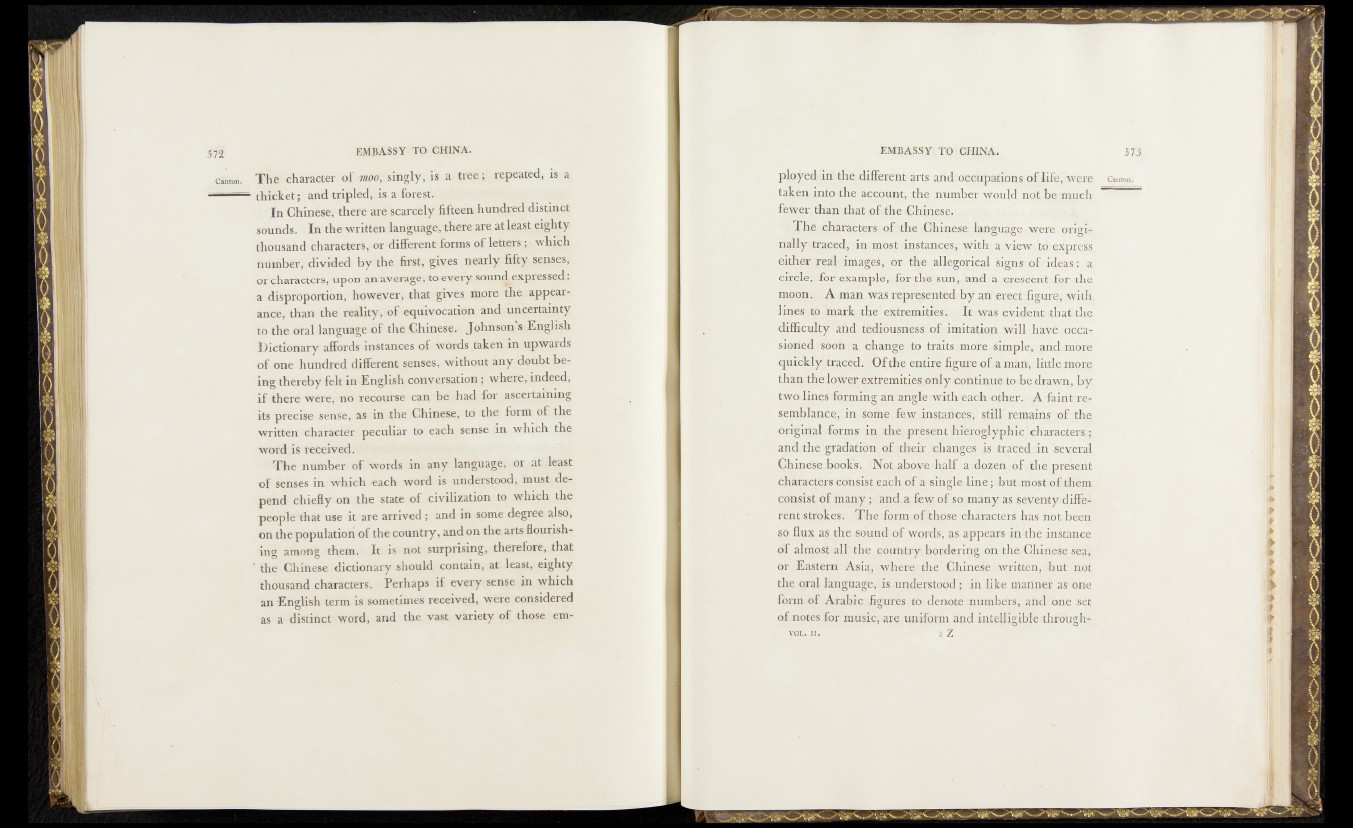
The character of moo, singly, is a tree; repeated, is a
thicket; and tripled, is a forest. -
In Chinese, there are scarcely' fifteen hundred distinct
sounds. In the written language; there are at least eighty
thousand characters, or different forms of letters; which
number, divided b y the first, gives nearly fifty senses,
or characters, upon an average, to every sound expressed:
a disproportion, however, that gives more die appearance,
than the reality, of equivocation and uncertainty
to the oral language of the Chinese. Johnson’s English
Dictionary affords instances o f words taken in upwards
of one hundred different senses, without any doubt be-'
tng thereby felt in English conversation ; where, indeed,
if there were, no recourse can be had for ascertaining
its precise sense, as inJthe Chinese, to the form oftthe
written character peculiar to each sense in which the
word is received.
The number of words in any language #;;ar, at least
of senses in which each word is understood, must de-
pend chiefly on the state of civilization to which the
people that use it ate arrived; and in some degree also,
on the population of the country, and on the arts flourishing
among them. It is not surprising, therefore, that
' the Chinese dictionary should contain, at least, eighty
thousand characters. Perhaps if every sense in which
an English term is sometimes received, were considered
as a distinct word, and the vast variety of those employed
-in the different arts and; occupations, of life, were
takenunto th^a^^pnt|l|^nurabepwonl(d' not be much
fewer than that of'the Chinese,jbjg
The chafactbrsciofiihe {Chinese! language .were origi-s;
n ally .traced, 'iusmosj: ■ instan.c;es;witfi? awiewito:pxpiies3
either-real im,ag$ly}c|& the allegorical signs ofyideas.:' a
ekelepjfor.exarhplb, 'fort he sun, hud; a jcreSceni rforvttik
moon. A man -kas kepr^jjtedjby an cruet ^figure, with
linesf-to imark the extremities--. It was ehidrent ..that the
difficulty's and .tediousness jof imitation williha^ev*QKf$ft*
sioUecfosoon»a bhang^it® traits: mote/simply,and mhte
qui’cklyjtraced.'''.Of the entire figure of a man litde apore-
thansthe lower extremities on|y rcontinue1to ibe,drawxji, b y
two dines forming an angle twithearch other. A'feidtiteV
semblax^de, in some^few .instances,' strll'rqaiadsns. ;of the
dri^mal forms in <the; present hiefaglyphic'ioharactersy.
and ihe' gradation of .their 'johaHgqs .js'»traced an ’.^gyeral
Chinese:book's. .'Not .above half, a.dozen .• o f . the.present
characters consisfeeach;o£ a single linebutiffiostipfitlten»
consist? of.many; and a few of Iso many as iavonty :diffed
rentsstrokes. _ The form,rof ihpse character^ has; no them
, so flux as;the:s6und.nf words, ;as appe^nkiidthe «instance
off almost.all -the gountry-borderipgidnvthp, Chinese.sea,
or Eastern Asia, where thevChinele written, hut mot
the oral language;ds .understood-;1 ifa like mariner as one
form of Arabic figures.;tbfd enote inumibers; and one :sefc
of .notes for music, are. uniform and-intelligible »throb gb?
vox.» y* s*wr j z